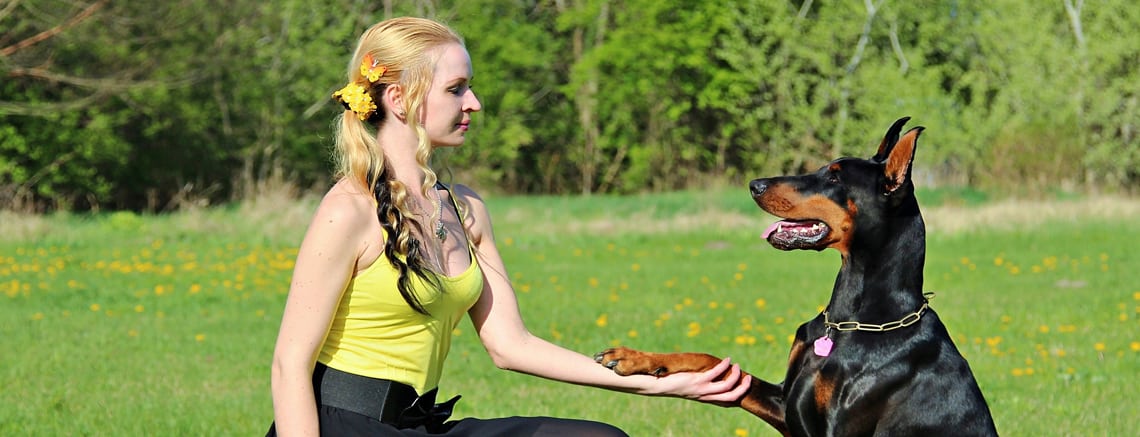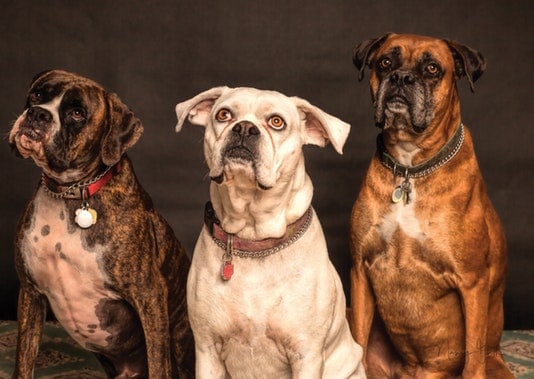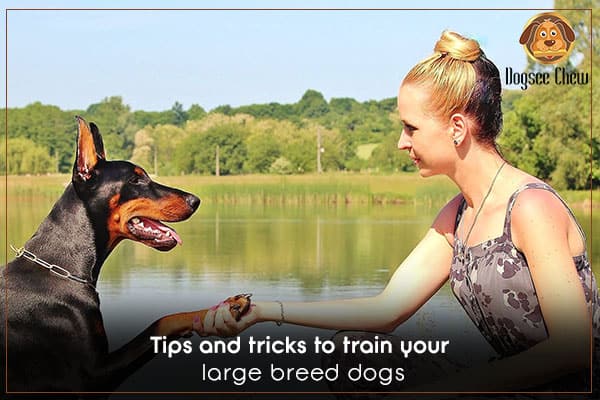
Large breed dogs can be quite intimidating for most dog parents. Although their size may not indicate so, large breed dogs are warm-hearted pets ideal for families and children. It’s important to realise that large breed dogs need to be trained while they are still a puppy before they grow to their full size. This is because if they aren’t taught discipline and obedience from a young age, it’ll be very difficult to control them once they are older and grow in size. For example, great breeds without proper behavioural training can be really rough while playing with kids and cause accidents. Thus, the earlier your large breed pup learns to behave, the better it’ll be for you to handle him.
Most often, the easiest way to overpower the imposing size of large breed dogs is to use a proper body language. The first step is to earn his/her respect. You can do that by maintaining eye contact and give commands firmly. Most often, even large breed dogs are just looking for some love. A simple system of rewarding them for good behaviour and punishment for bad behaviour will suffice. You wouldn’t need to hit your dog physically to make him/her obey you.
As long as you diminish the impact of his size with your actions like a firm voice, he/she will start respecting you.
Tips To Train Large Breed Dogs

Training large breed dogs are quite similar to training other dogs except for the focus, which should be on positive reinforcement and exercise patience. You have to remain calm and stern throughout the entire stage of training your dog and it should be perfectly fine.
Here are the various tips and tricks to help you train your dog successfully.
Stage 1: The Beginning
Start Early
Begin your training when your dog is aged lesser than 1 year old as it helps in inculcating behaviour early. The best thing is to begin the training as soon as you bring it home.
To make the training enjoyable for the dog, mix it with a little play too. Conduct short sessions so as not to stress the dog. Once it gets older, extend the training sessions for longer.
Reward-based Training
Large breed dogs don’t perform well with punishment. Moreover, it may have an adverse impact on them and they may fight back which will cause accidents. However, rewarding them for their behaviour is a good option. You can use some healthy training treats for puppies to reward them when they obey your commands. A favourite toy, some verbal appreciation or a friendly pat also works.
Clicker Training
This is a form of sound training where your dog associates a particular sound with a certain action. In this case, you can use a clicker to make your dog get used to a certain idea like getting rewarded. The dog can then immediately recognise the sound of the clicker as the time to get rewarded. You can buy a clicker from a local pet store.
Fix a Proper Schedule
Consistency is the key here. When starting out, you can do 2 sessions a day for about 15-20 minutes each. The ideal schedule is to do 1 in the morning and 1 in the afternoon. Creating a regular schedule will help the dog to get used to the behaviour.
Stage 2: Basic Commands
Sit
Teaching a dog to sit can help in a variety of situations. It helps them to calm down in pressure situations. Start by showing your dog the treat and hovering it at his/her nose level. Following the treat, the dog will put its bottom down to reach up for the treat. After he/she does so, you can reward him/her. Give the command in a clear and firm voice.
Stay
This command comes in conjunction with the previous one. This step is important to prevent the dogs from rushing towards people. To help the dog learn to stay, after he/she sits take a step back and order him to stay in a stern voice. Give him a reward if he doesn’t move. Keep increasing the distance and rewarding him.
Drop It
Big dogs get access to lot of things due to their size. So they may get into a habit of pulling and breaking things. Thus teaching them to drop it is an important task. You can start by teaching the dog to pick something like a toy up and then ordering him/her to drop it in return for a reward. If you see the dog’s jaw relaxing, give the command to drop it. Appreciate the dog for its behaviour and give a treat as a reward.
Stage 3: Avoid Common Mistakes

Don’t use Physical Guidance Only
You can use mild physical guidance like pushing him/her for smaller dogs but the same doesn’t work on larger breeds. Instead, vocal orders and positive reinforcement works best.
Use The Right Body Language
The idea is not to set yourself as a leader but a strong enforcer of commands. Thus using eye contact and giving orders in a firm voice will help in earning your dog’s respect.
Choose Positive Reinforcement Instead of Punishment
It’s never advisable to scold or punish your dog. Smaller dogs don’t react to it well and larger dogs may react in a negative way. It can also turn them aggressive which is a bad thing for you and if you have children in your home. Treating them to rewards is a much better option. For example, if you are angry, instead of yelling at your dog, just walk away
Use a Leash while Training
If you think your dog can be aggressive or you are unable to control them, you can use a leash during training them. If he/she behaves in an uncontrolled way, just pull at his/her leash to calm him/her down. You can also use a collar or a muzzle if required.
Keep Children and Animals Away while Training
It’s important to train your dogs in a calm and quiet environment where they won’t get agitated a lot. Put other pets, if you have any, in a separate room. Also keep children away during training as it will keep them safe.
Be Consistent
A behaviour can only be enforced when you're consistent. Make sure to remind the dog to behave every time you see him/her doing other than what you’ve ordered.
Training your dog may seem like a mammoth task but it’s not. If you follow some simple guidelines and be firm and consistent, you can ensure that your dog will behave in an orderly fashion. Also, starting early will help you have a more well-behaved dog.
Happy training!
